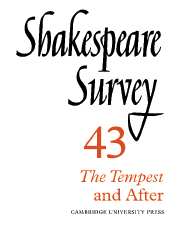Book contents
- Frontmatter
- The Power of Magic: From Endimion to The Tempest
- Reading The Tempest
- The Latter End of Prospero’s Commonwealth
- Henry VIII and the Deconstruction of History
- The Politics of Conscience in All is True (or Henry VIII)
- Shakespeare’s Romantic Innocents and the Misappropriation of the Romance Past: The Case of The Two Noble Kinsmen
- The Hand of John Fletcher in Double Falsehood
- ‘The Duke my Father’s Wrack’: The Innocence of the Restoration Tempest
- ‘Remember/First to Possess his Books’: The Appropriation of The Tempest 1700-1800
- The Tempest and After
- Poetry’s Sea-Changes: T. S. Eliot and The Tempest
- The New Function of Language in Shakespeare’s Pericles: Oath versus ‘Holy Word’
- The Discovery of The Rose Theatre: Some Implications
- The Origins of the Roxana and Messallina Illustrations
- Recycling the Early Histories: ‘The Wars of the Roses’ and ‘The Plantagenets’
- Shakespeare Production in England in 1989
- Professional Shakespeare Productions in the British Isles, January-December 1988
- The Year's Contributions to Shakespeare Studies: 1 Critical Studies
- 2 Shakespeare’s Life, Times, and Stage
- 3 Editions and Textual Studies
- Books Received
- Index
‘Remember/First to Possess his Books’: The Appropriation of The Tempest 1700-1800
Published online by Cambridge University Press: 28 March 2007
- Frontmatter
- The Power of Magic: From Endimion to The Tempest
- Reading The Tempest
- The Latter End of Prospero’s Commonwealth
- Henry VIII and the Deconstruction of History
- The Politics of Conscience in All is True (or Henry VIII)
- Shakespeare’s Romantic Innocents and the Misappropriation of the Romance Past: The Case of The Two Noble Kinsmen
- The Hand of John Fletcher in Double Falsehood
- ‘The Duke my Father’s Wrack’: The Innocence of the Restoration Tempest
- ‘Remember/First to Possess his Books’: The Appropriation of The Tempest 1700-1800
- The Tempest and After
- Poetry’s Sea-Changes: T. S. Eliot and The Tempest
- The New Function of Language in Shakespeare’s Pericles: Oath versus ‘Holy Word’
- The Discovery of The Rose Theatre: Some Implications
- The Origins of the Roxana and Messallina Illustrations
- Recycling the Early Histories: ‘The Wars of the Roses’ and ‘The Plantagenets’
- Shakespeare Production in England in 1989
- Professional Shakespeare Productions in the British Isles, January-December 1988
- The Year's Contributions to Shakespeare Studies: 1 Critical Studies
- 2 Shakespeare’s Life, Times, and Stage
- 3 Editions and Textual Studies
- Books Received
- Index
Summary
The eighteenth century inherited two versions of The Tempest. One was an established classic, immensely popular in the theatre and the subject of countless allusions outside it: The Tempest, or the Enchanted Island, adapted by Dryden and Davenant in 1667 and provided with further operatic embellishments by Shadwell in 1674. The other was the play which appears first in the Shakespeare Folio, The Tempest, which had not been performed since its author’s lifetime and would not be revived in anything like its original form until 1746. The history of these competing texts in eighteenth-century culture, which this paper will endeavour to illuminate, is not a simple matter of the Restoration’s spurious, usurping Enchanted Island gradually succumbing to the inevitable rise of Bardolatry in favour of the true, Shakespearian Tempest, although this is how it has always tended to be represented. It is rather the history of how new concepts of Shakespeare – new ideas of the meanings and uses of Great English Literature – conspire both with and against new readings of The Tempest to produce a series of new Prosperos, new Mirandas, and new Calibans over the course of the century – whether in fresh stage versions like Garrick’s operetta of 1756, the puppet version of 1780 or Kemble’s play of 1789, or in other media: novels, statues, poems, literary criticism.
- Type
- Chapter
- Information
- Shakespeare Survey , pp. 99 - 108Publisher: Cambridge University PressPrint publication year: 1991
- 1
- Cited by



